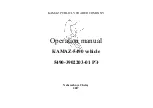
Utilimaster Corporation attempts to provide
information that is accurate, complete, and
useful. All information contained in this
manual is based on the latest product infor-
mation available at the time of publication.
However, because of the Utilimaster policy
of continual product improvement, Utilimas-
ter reserves the right to amend the informa-
tion in this document at any time without
prior notice.
This material is confidential and the prop
-
erty of Utilimaster. It is shared with your
company for the sole purpose of helping you
with the operation of the described equip-
ment.
Utilimaster makes no warranty of any kind
with regard to this material, including, but
not limited to, the implied warranties of
merchantability and fitness for a particular
purpose. Utilimaster shall not be liable for
errors contained herein or for incidental or
consequential damages in connection with
the furnishing, performance, or use of this
material.
Utilimaster expressly disclaims all respon-
sibility and liability for the installation, use,
performance, maintenance, and support of
third-party products. Customers are advised
to make their independent evaluation of such
products.
No part of this document may be photo-
copied, reproduced, or translated to another
language without the prior written consent
of Utilimaster.
Utilimaster Corporation attempts to provide
information that is accurate, complete, and
177
For Assistance Call: 800-237-7806
Parts On-line:
https://parts.utilimaster.com
Reach—Body Service Manual
Fax: 574-862-7637
Towing the Vehicle
Always follow state and local laws, related to the towing of vehicles.
Using a Lowboy Trailer
Because the height of the Reach is not typically suitable for a standard flatbed trailer or rollback truck, a
lowboy trailer is the preferred method for moving the vehicle.
Towing From the Front
If a lowboy trailer is not available, the recommended method of towing is with a front axle lift. The
drive shaft should be removed from the rear axle and left attached to the transmission to prevent fluid
loss from the transmission. Secure the drive shaft under unit. The rear axle shaft may need to be
removed if there is damage or suspicion of damage to the rear end.
WARNING: When servicing a vehicle, follow safe practices, including these recommendations:
•
Always wear safety glasses and other protective equipment as appropriate to the process.
• NEVER attempt a towing operation that jeopardizes the safety of the wrecker operator,
bystanders, or passing motorists.
•
Operators should refrain from going under a vehicle which is being lifted by towing equipment
unless the vehicle is adequately supported by safety stands.
• Vehicles must not be towed at speeds in excess of 55 MPH [88km/h].
• Always attach towing equipment to main structural components. NEVER tow the vehicle by the
bumpers, tow hooks, or brackets.
•
Always use towing equipment appropriately sized and designed for the express purpose of
towing vehicles.
•
Always follow the wrecker manufacturer’s instructions.
•
Always make sure that safety chains are used when towing and ensure that they are
appropriately rated.
• The towing service must be qualified and follow best contemporary industry practices.
•
A sling or draw bar lift is NOT recommended for towing the Reach vehicle.
•
Loose or protruding parts of damaged vehicles should be secured prior to moving.
• Do NOT flat tow for more than one mile at a maximum speed of 30 MPH.
•
If the drive shaft is removed, the parking brake is inoperable.
•
Always chock the wheels of the towed vehicle when connecting and BEFORE disconnecting it
to prevent it from rolling.
CAUTION: Proper equipment must be used to prevent damage to towed vehicles.
CAUTION: Do NOT lift the vehicle by the rear bumper or frame extensions.




































